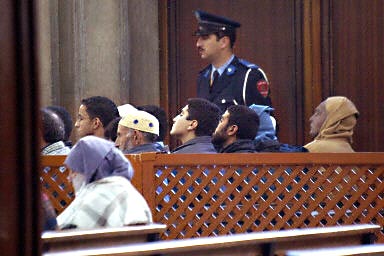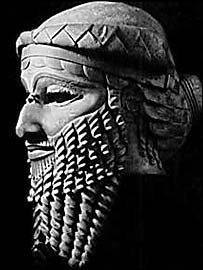|
Morocco:
13 youths convicted of anti-Muslim acts
Heavy metal youths, Egyptian jailed from month to year for acts deemed
satanic, anti-Islamic in Casablanca.
CASABLANCA
- Thirteen young Moroccans and an Egyptian were sentenced in Casablanca
Thursday to prison terms ranging from a month to a year for "acts
that could shake Muslims' faith" in a case linking heavy-metal music
to satanism that has divided opinion in the north African nation.
The
trial has triggered condemnation from the press and non-governmental
organisations, who have accused the authorities of a baseless witch hunt.
The
accused, aged 20 to 28 and mostly from middle-class backgrounds, were
taken into custody on February 16 for disturbing public order and
reportedly possessing items including T-shirts depicting the devil and
death which were considered anti-Islamic.
The
Egyptian, Mohamed Ali Kamel, who ran a Casablanca cafe, was also served an
expulsion order which will go into effect once his year-long jail sentence
is completed.
The
heavy-metal fans were also charged in court with "possession of
objects that breach good morals" and complicity in promoting
prostitution - a reference to their meeting place, Kamel's cafe.
During
the trial, the defendants had pleaded their innocence, reciting passages
from the Koran in a bid to prove they were devout Muslims.
Prosecution
evidence against them included skeletons, skulls, cobras, vipers and
"a collection of diabolical CDs", according to independent
weekly newspaper Maroc-Hebdo, which said the youths had "a guru who
practices mental manipulation on his followers".
|

There
was media uproar when the case came to court last month, with the
independent weekly Tel Quel denouncing the case as "absurd" and
calling the attitude of the Moroccan police and judiciary system worrying.
"Apart
from their musical tastes, nothing marks them out from their neighbors in
the derb (neighborhood), who are no more, nor less Muslim than the
average," Tel Quel said in an article headlined: "Scary
Morocco".
"Today
heavy metal fans are apostates. Whose turn will it be tomorrow?" it
asked.
For
its part, conservative Islamic daily Attajdid had written off the
"campaign" against the youths as "doomed to fail".
"This
campaign... is undermined by other campaigns that encourage all forms of
delinquency, alcohol and licentiousness which are ignored by the
authorities," it wrote last month.
One
of the lawyers for the defense, Ahmed Mahfoud Billah, had called the
accusations against his clients "imaginary" and had complained
to the Maroc Hebdo weekly that just listening to music and wearing black
T-shirts was considered a crime.
Another
defense lawyer called the trial a "witch hunt aimed at pleasing
Islamists".
|
|
Gilgamesh tomb believed found
Gilgamesh was believed to be two-thirds god,
one-third human
Archaeologists in Iraq believe they may have found
the lost tomb of King Gilgamesh - the subject of the oldest book in
history.
The Epic Of Gilgamesh - written by a Middle Eastern
scholar 2,500 years before the birth of Christ - commemorated the life of
the ruler of the city of Uruk, from which Iraq gets its name.
 Now
a German-led expedition has discovered what is thought to be the entire
city of Uruk - including, where the Euphrates once flowed, the last
resting place of its famous King. Now
a German-led expedition has discovered what is thought to be the entire
city of Uruk - including, where the Euphrates once flowed, the last
resting place of its famous King.
"I don't want to say definitely it was the grave
of King Gilgamesh, but it looks very similar to that described in the
epic," Jorg Fassbinder, of the Bavarian department of Historical
Monuments in Munich, told the BBC World Service's Science in Action
programme.
In the "book" - actually a set of inscribed
clay tablets - Gilgamesh was described as having been buried under the
Euphrates, in a tomb apparently constructed when the waters of the ancient
river parted following his death.
"We found just outside the city an area, in the
middle of the former Euphrates river, we detected the remains of a such a
building which could be interpreted as a burial," Mr Fassbinder said.
Who can
compare with him in kingliness? Who can say, like Gilgamesh, I am king?
|
 The
Epic Of Gilgamesh The
Epic Of Gilgamesh
He said the amazing discovery of the ancient city
under the Iraqi desert had been made possible by modern technology.
"By differences in magnetisation in the soil,
you can look into the ground," Mr Fassbinder added.
"The difference between mudbricks and sediments
in the Euphrates river gives a very detailed structure."
This creates a "magnetogram", which is then
digitally mapped, effectively giving a town plan of Uruk.
'Venice in the desert'
"The most surprising thing was that we found
structures already described by Gilgamesh," Mr Fassbinder stated.
Iraq has long been the site of some of the most
important historical finds
"We covered more than 100 hectares.
"We have found garden structures and field
structures as described in the epic, and we found Babylonian houses."
But he said the most astonishing find was an
incredibly sophisticated system of canals.
"Very clearly, we can see in the canals some
structures showing that flooding destroyed some houses, which means it was
a highly-developed system.
"[It was] like Venice in the desert."
|
|
Enlightened by compassion
As the eighth day of the fourth lunar month approaches
- May 8 this year - lanterns are prepared at Buddhist temples to mark the
traditional birth date of the founder of Buddhism, Siddhartha Gautama, known
as the Buddha, or Enlightened One, who lived in northern India in the 5th
century B.C.
Jogye Temple`s colorful lanterns contain the written
wishes of believers.
Meticulously preparing lotus lanterns or elaborate,
sometimes whimsical, floats for the lantern parade, Buddhists and
non-Buddhists alike enter the stream of history and tradition. This stream
itself illuminates the nuanced 1,700-year history of Buddhism in Korea.
The association of lanterns with the Buddha originated
during the Buddha's lifetime, when his followers would bear lanterns to hear
his sermons at night. "One such night," relates Hong Min-suk, the
Jogye Order's organizer of the lantern parade and its director of public
relations, "A strong wind extinguished all the lanterns but one, that
borne by a poor old woman. The Buddha immediately acknowledged that she
would be reborn a Buddha."
There are numerous legends to account for the
traditional, non-Buddhist lantern festival in China, held during the first
full moon of the year since the earliest dynasties. These events were
contemporary with the Buddha's lifetime, but independent and unrelated to
that religion, which would not enter China until the 1st century A.D. Like
pre-Christian winter solstice rites in the West from which the tradition of
"Christmas lights" derives, the lantern festivals in China were
designed to attract the attention and mercy of the gods during winter's
darkness. This tradition was first conflated with Buddhist ritual in China
by Emperor Mingdi of the Eastern Han dynasty (25 A.D. - 220), the first
emperor to promote Buddhism there.
Buddhism entered the Korean Peninsula from China in the
4th century A.D. The Goguryeo (37 B.C. - 668 A.D.) and Baekje (18 B.C. - 660
A.D.) kingdoms almost simultaneously adopted the ritual protocols of Chinese
Buddhism, including the use of lanterns. At this time the religion-not yet
matured as a speculative or meditative discipline-was practiced as a form of
magical national protection, with the staging of mass rituals also practiced
in China.
Based on the Sutra of Golden Light and the Benevolent
King Sutra, they effectively identified the king, who played a central role
in the rites, with the Universal Wheel-Turning King, that is the Buddha, as
protector of the nation just as the Buddha is protector of the dharma, or
universal law. In other words, Buddhism was more a political phenomenon than
a spiritual one. The earliest recorded instance of the use of lanterns in a
Buddhist rite in Korea (although they were certainly employed before this in
Goguryeo and Baekje) was a Ceremony of the Eight Vows conducted in 551 A.D.
in the Silla Kingdom (57 B.C. - 935 A.D.).
It wasn't until the late Unified Silla period that the
more theoretical aspects of Buddhism, which inform it still today, were
established in Korea. The most influential texts in these schools were the
Lotus Sutra and the Avatamsaka Sutra, both of which emphasize the symbolism
of light. In these texts, the Buddha bathes the entire universe, from the
lowest hell to the highest heaven, and all six realms of existence with the
light of his wisdom and compassion. The light in these texts also serves as
a metaphor for the Mahayana concept of the universality of the Buddha.
There is also the story in the Lotus Sutra of the
origin of the Medicine Buddha, who as an aspiring monk in a former life
immolates himself - indeed, making of himself a living lantern - as an
offering to the Buddha. Consequently the Lotus Sutra emphasizes that candles
are the most fundamental of offerings, and one finds no shortage of them
stacked in boxes behind the main altar, donated by the supporters of the
temple. This form of donation, and the lanterns donated for the lantern
festival (with streamers hanging from them signed by the donors) are clearly
in this spirit of offering to the Buddha.
|

The lantern festival as we know it today - that is, as a festival of the
masses - has its origins in the late Goryeo period (918 - 1392). Early in
the Goryeo, lantern assemblies were held every year on the fifteenth day of
the first month in concurrence with the Chinese New Year lantern festival.
The use of lanterns was transformed and reinterpreted
from king to king in the Goryeo, with many and various lantern processions
and rites at temples and palaces recorded in the court-scribed history of
the dynasty. Some of these rites were devoted to the Buddha, some to
Manjusri (the bodhisattva of wisdom), and some to Maitreya (the future
Buddha). Some rites are recorded with up to thirty thousand monks (and
lanterns) in attendance.
To appreciate the size of such spectacular assemblies,
bear in mind that roughly this same number of people and lanterns - some
30,000 - participate in the modern lantern parade in Seoul, which fills
Jongno Avenue from sidewalk-to-sidewalk in a solid procession from
Dongdaemun Stadium to Jogye Temple. Whereas the modern parade pays for
itself, and in fact returns revenue to the local economy (by attracting
visitors), the Goryeo rites were government-sponsored, paid for essentially
by the overtaxed populace. This underscores the elaborate aesthetic tastes
of Goryeo royalty, and the profligate ceremonialism of the period by which
the dynasty ultimately collapsed, and because of which severe restrictions
were imposed on Buddhism in the conservative, rational Joseon dynasty.
It wasn't until the reign of Gong-min (r. 1351-1374),
one of the last Goryeo kings, that, through his promotion of it to the
general public, the masses began to participate with enthusiasm in lantern
processions. "Children would produce banners on bamboo poles entreating
door-to-door for items with which to make lanterns," relates Hong.
Because of its corrupted ties to the aristocracy during
the Goryeo, Buddhism fell out of favor with the Confucian court of the
Joseon period, until the devastating Hideyoshi invasions of the late 16th
century. This period saw transformations in the aims and the patronage of
Buddhism, which remain to the present. Whereas Buddhism had been largely an
imperial and aristocratic religion through the Goryeo, devoted to rites of
national protection and the legitimization of kingship, during the Joseon
the Confucian government undertook the ritualistic protection of the nation.
However, Buddhism survived by addressing the national anxiety concerning
wandering ghosts, which became especially acute after the Hideyoshi
devastation.
The patrons of Buddhism became increasingly of the
growing middle (merchant) class of the period. Not being
"high-born" yangban, these nouveau riche of the period created
their own internal economy of cultural capital by investing in Buddhist
projects. And so it was that shopkeepers in the markets of Jongno in Seoul,
from the late Joseon, maintained the tradition of making Buddhist lanterns.
According to Hong, "They hung them from their shops, right here in this
neighborhood, and ascended Mt. Nam to view the spectacle from on high."
Further, he explains, "The lantern parade down
Jongno Avenue itself originated during the Japanese occupation [of
1910-1945], when the Japanese combined their Buddha's birthday flower parade
with the Korean lantern festival tradition. After the occupation, the Jogye
Order undertook organizing the lantern parade, and does so to the
present."
In a small, crowded and busy office at Jogye Temple in
Seoul where the annual event is being organized down to its minutest
logistical details - with maps, charts, and banners and heaps of lanterns -
Hong shares his interpretation of the symbolism of the event.
"Even the Buddha's final words used the imagery of
a lantern," he explained. "He said, 'Regard your true self as a
lantern. Trust in the Buddha-light inside of you.' The lantern and the
lantern parade are an acknowledgement of this teaching."
Although the Buddha's birthday is on May 8 this year,
the lantern parade will be held on Sunday, May 4.
By Lou Morrison Contributing writer (loumorrison3@yahoo.com)
|

